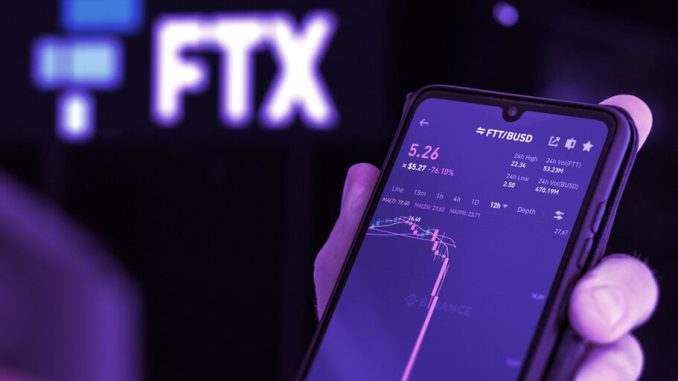
Welcome back to our weekly recap of crypto market moves over the past seven days.
Just when the industry was beginning to think Crypto Winter had passed, the sudden cinematic collapse of crypto exchange FTX this week sent prices spiraling down across the board.
Bitcoin (BTC) and Ethereum (ETH) crashed in sync, both losing about 20% of their value over the past seven days, according to CoinGecko data.
The world’s top cryptocurrency Bitcoin (BTC) currently trades at $16,872, a price not seen since November 2020 when it began its pandemic-fueled bull run.
The second largest cryptocurrency by market capitalization, Ethereum (ETH), is today trading at around $1,274—a bottom that last occurred in early July.
The steepest loss in the top fifty cryptocurrencies was felt by Solana (SOL) holders, who found their pot shrank by 47% in the last seven days. SOL is changing hands at $16.26.
FTX CEO Sam Bankman-Fried was one of Solana’s earliest backers and also owned a large stash of SOL through his other crypto company, Alameda Research. SOL was the second-largest coin holding of the disgraced hedge fund.
Broadly speaking, double-digit percentile losses were extremely common this week. XRP and privacy coin Monero (XMR) both posted similar losses to the two market leaders, with XRP starting the weekend at 38 cents and Monero trading for $127.
Steep losses were also felt by Dogecoin (DOGE) holders, who are down 31% to $0.084633; Avalanche (AVAX) crashed 23% to $13.96, and Algorand (ALGO) dropped 18% to 13 cents.
FTX total meltdown
Nobody saw this one coming—but they probably should have.
Back at the start of summer, when Terra’s collapse triggered a wave of bankruptcies, Sam Bankman-Fried was the first industry billionaire to open his purse strings to offer bailouts left, right and center.
On paper, at the time, he looked like he could afford it.
At the height of his wealth in March, Bankman-Fried was worth an eye watering $26 billion. In October last year, Forbes called him “The World’s Richest 29-Year-Old” and “the richest self-made newcomer in Forbes 400 history.” Fortune asked on its cover if he was “the next Warren Buffett.”
The image cracked this week. It started when Binance CEO Changpeng Zhao declared he would move to liquidate his exchange’s entire FTT holdings—FTT is FTX’s native token—citing “recent revelations” about FTX allegedly lobbying “against other industry players behind their backs.”
Zhao’s tweet caused a bank run as FTX customers began withdrawing funds from the exchange en masse. A whopping $6 billion exited FTX in 72 hours. To put it into perspective, the exchange ordinarily handled “tens of millions” in withdrawals on an average day. In an all-too-familiar pattern, withdrawals were “effectively paused” due to the exchange’s liquidity troubles. According to a source that spoke to Reuters, the decision to freeze was made at the very top.
The FTT token got wiped out over the course of the week. On Sunday it was worth around $25. Today it trades for almost a tenth of the price.
Things took an interesting turn on Tuesday when Binance entered a non-binding agreement to bail out FTX for an undisclosed amount. Zhao called the situation “highly dynamic,” clarifying that his exchange “has the discretion to pull out of the deal at any time.” And that’s just what it did on the following day. Zhao said FTX was “beyond our ability to help.”
It turns out the potential rekindling of Zhao and Bankman-Fried’s crypto bromance was mired by the necessary due diligence. In a tweeted statement, Binance attributed its u-turn to the “latest news reports regarding mishandled customer funds and alleged US agency investigations” and said “the issues are beyond our control or ability to help.”
Throughout the week, several crypto companies disavowed any connection to the beleaguered FTX, including Coinbase, Circle, Tether and Maple Finance. However, as with Terra, the contagion is likely to keep spreading.
On Wednesday, crypto-focused financial services firm Galaxy Digital announced it had a $76.8 million exposure to FTX. The following day, crypto investment and trading group CoinShares said it had $30.3 million in crypto locked up in FTX which it has been unable to withdraw thus far.
The final act of the FTX drama began on Thursday when the Securities Commission of the Bahamas, where FTX is headquartered, issued an order to freeze the FTX’s assets. The Bahamian regulator suspended the exchange’s operation registration and asked the Supreme Court for a provisional liquidator to be appointed.
The crisis concluded on Friday with the news that FTX filed for Chapter 11 bankruptcy. Alameda Research, along with the exchange’s American subsidiary FTX.US and roughly 130 affiliated entities will also be filing for bankruptcy.
Bankman-Fried has now resigned from his role as CEO and veteran bankruptcy lawyer John J. Ray III will fill his shoes. Ray previously shepherded Enron through its bankruptcy proceedings—a fitting parallel.
This week the industry watched one of the fastest contractions of wealth in history. In the coming months, the true scale of the damage will become more clear.
The disgraced former FTX CEO tweeted on Friday, “I’m really sorry, again.”






Be the first to comment